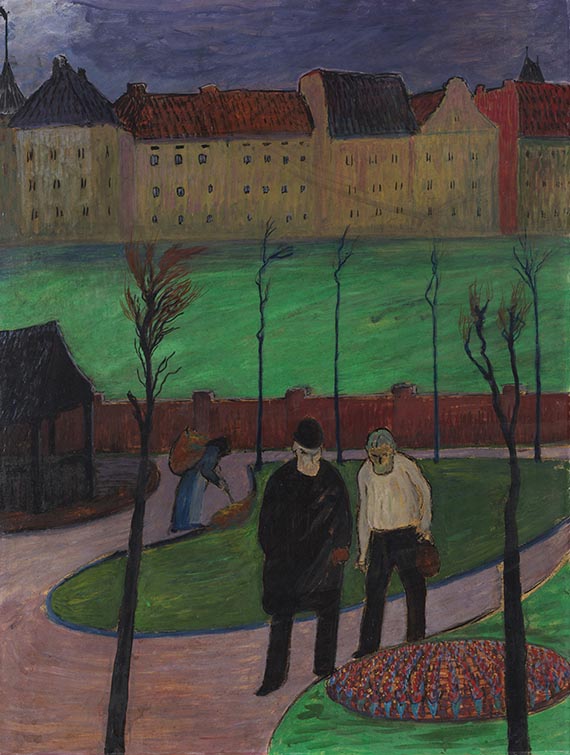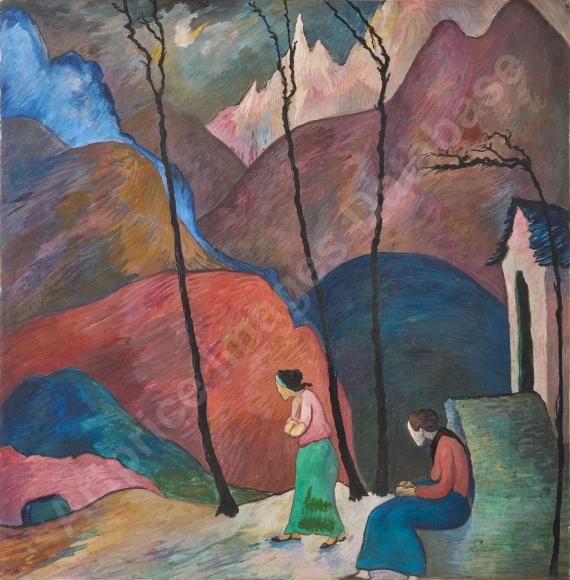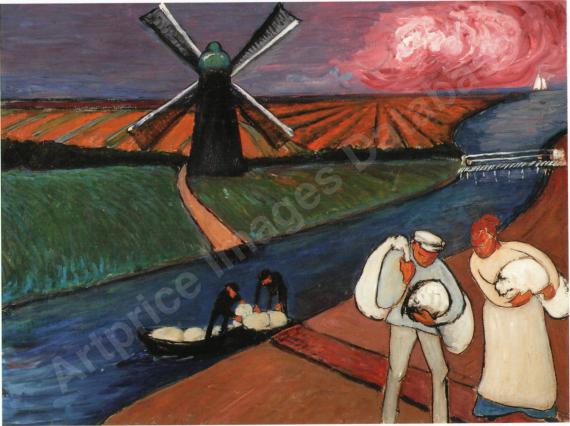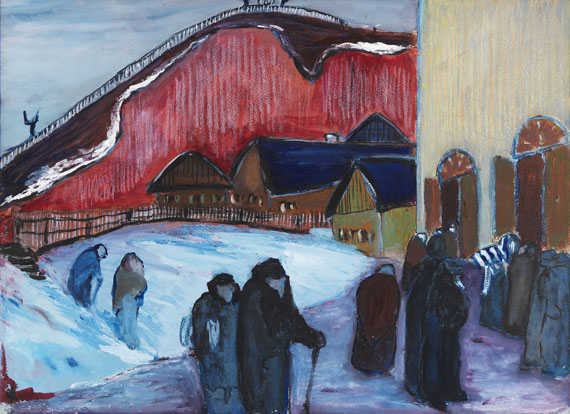Sale: 590 / Evening Sale, June 06. 2025 in Munich  Lot 125000353
Lot 125000353
 Lot 125000353
Lot 125000353
125000353
Marianne von Werefkin
Am Blumenbeet, Wohl um 1910/14.
Öl-Tempera on paper, laminated on board
Estimate:
€ 80,000 - 120,000
$ 86,400 - 129,600
Information on buyer's premium, taxation and resale right compensation will be available four weeks before the auction.
Am Blumenbeet. Wohl um 1910/14.
Öl-Tempera on paper, laminated on board.
Monogrammed and inscribed with the address "No. 5 Gisellastr", as well as titled on the reverse of the carrdboard. 74.2 x 56 cm (29.2 x 22 in). Cardboard: 75,5 x 57,3 cm (29,7 x 22,5 in).
• Marianne von Werefkin's painting embodies an artistic vision brimming with suggestive intensity.
• Created in the context of Der Blaue Reiter (The Blue Rider), Werefkin exhibited three works at the exhibition in Herwarth Walden's Berlin gallery 'Der Sturm' in 1912.
• In 1961, “Am Blumenbeet” was shown in the exhibition “les sources du XXe siècle” at the Centre Pompidou in Paris.
• Most recently, the Museum de Fundatie in Zwolle, Netherlands, honored Marianne von Werefkin's important role in the exhibition “Marianne von Werefkin - Pionierin des Expressionismus” (Oct. 2024 - March 2025).
PROVENANCE: Max Niedermayer Collection, Wiesbaden (until 1968).
Max Niedermayer Estate, Wiesbaden (until 1979).
Private collection, Rhineland-Palatinate (acquired from the above in 1979).
Ever since family ownership.
EXHIBITION: Marianne Werefkin 1860-1938, Memorial Exhibition, Städtisches Museum, Wiesbaden / Städtische Kunstsammlung, Bonn / Kunstverein Frankfurt a. Main / Städtische Galerie, München / Kunsthalle Bremen / Kunst- und Museumsverein, Wuppertal / Staatliche Kunsthalle, Baden-Baden / Museum Ostwall, Dortmund, 1958, cat. no. 10 illustrated.
les sources du XXe siècle- les arts en europe de 1884 a 1914, Musee national d'art modern - Centre George Pompidou, Nov.4 - Jan. 23, 1961.
Öl-Tempera on paper, laminated on board.
Monogrammed and inscribed with the address "No. 5 Gisellastr", as well as titled on the reverse of the carrdboard. 74.2 x 56 cm (29.2 x 22 in). Cardboard: 75,5 x 57,3 cm (29,7 x 22,5 in).
• Marianne von Werefkin's painting embodies an artistic vision brimming with suggestive intensity.
• Created in the context of Der Blaue Reiter (The Blue Rider), Werefkin exhibited three works at the exhibition in Herwarth Walden's Berlin gallery 'Der Sturm' in 1912.
• In 1961, “Am Blumenbeet” was shown in the exhibition “les sources du XXe siècle” at the Centre Pompidou in Paris.
• Most recently, the Museum de Fundatie in Zwolle, Netherlands, honored Marianne von Werefkin's important role in the exhibition “Marianne von Werefkin - Pionierin des Expressionismus” (Oct. 2024 - March 2025).
PROVENANCE: Max Niedermayer Collection, Wiesbaden (until 1968).
Max Niedermayer Estate, Wiesbaden (until 1979).
Private collection, Rhineland-Palatinate (acquired from the above in 1979).
Ever since family ownership.
EXHIBITION: Marianne Werefkin 1860-1938, Memorial Exhibition, Städtisches Museum, Wiesbaden / Städtische Kunstsammlung, Bonn / Kunstverein Frankfurt a. Main / Städtische Galerie, München / Kunsthalle Bremen / Kunst- und Museumsverein, Wuppertal / Staatliche Kunsthalle, Baden-Baden / Museum Ostwall, Dortmund, 1958, cat. no. 10 illustrated.
les sources du XXe siècle- les arts en europe de 1884 a 1914, Musee national d'art modern - Centre George Pompidou, Nov.4 - Jan. 23, 1961.
Inscribed with the artist's address on the reverse, “Am Blumenbeet” verifies Marianne von Werefkin's time in Munich. In 1896, she left St. Petersburg for the art hub Munich. Together with her maid Helene Nesnakomoff and her partner Alexej von Jawlensky, she lived in a spacious apartment at Giselastraße 23. The daughter of a wealthy Russian nobleman established the salon of the “Giselists,” a discussion group of artists and writers that soon enjoyed a reputation as the meeting place of Munich's avant-garde.
Wassily Kandinsky and Gabriele Münter were also regular guests at the salon. Back in Russia, Werefkin was a student of Ilya Repin, the country's most important realist painter, also known as the “Russian Rembrandt.” In Munich, she selflessly gave up her career for 10 years to support Jawlensky, who had long been in a romantic relationship with her maid Helene. Eventually, Jawlensky married Helene in 1922, which made for a highly delicate and tense situation. Werefkin did not return to painting before 1906, at which point she immediately produced a series of impressive, innovative, and distinctive compositions.
“Am Blumenbeet” (At the Flower Bed) shows two strollers deeply engaged in a conversation in front of an urban backdrop, as might have been seen from one of Munich's parks. The ambivalent mood characteristic of Werefkin's paintings lingers in the air. A sky rendered in a dramatic shade of blue looms above the dreary row of houses, the lush green lawn, and the path lined with barren trees. The eponymous flower bed occupies a relatively small area to the side. A female figure, who appears to be a gardener, stands slightly back on the left side of the park. Werefkin selected her colors without any purely descriptive effect. Instead, she filled them with meaning. Threatening and calming elements unite to create a compelling whole. The conversation and intense exchange of ideas between the two figures pausing in front of the blossoming flower bed take center stage. The role of the nursing gardener, which Werefkin herself played for Jawlensky for many years, is clearly reflected in the composition. Elements of her personal life can be found in this composition, providing insight into her emotional world. [EH]
Wassily Kandinsky and Gabriele Münter were also regular guests at the salon. Back in Russia, Werefkin was a student of Ilya Repin, the country's most important realist painter, also known as the “Russian Rembrandt.” In Munich, she selflessly gave up her career for 10 years to support Jawlensky, who had long been in a romantic relationship with her maid Helene. Eventually, Jawlensky married Helene in 1922, which made for a highly delicate and tense situation. Werefkin did not return to painting before 1906, at which point she immediately produced a series of impressive, innovative, and distinctive compositions.
“Am Blumenbeet” (At the Flower Bed) shows two strollers deeply engaged in a conversation in front of an urban backdrop, as might have been seen from one of Munich's parks. The ambivalent mood characteristic of Werefkin's paintings lingers in the air. A sky rendered in a dramatic shade of blue looms above the dreary row of houses, the lush green lawn, and the path lined with barren trees. The eponymous flower bed occupies a relatively small area to the side. A female figure, who appears to be a gardener, stands slightly back on the left side of the park. Werefkin selected her colors without any purely descriptive effect. Instead, she filled them with meaning. Threatening and calming elements unite to create a compelling whole. The conversation and intense exchange of ideas between the two figures pausing in front of the blossoming flower bed take center stage. The role of the nursing gardener, which Werefkin herself played for Jawlensky for many years, is clearly reflected in the composition. Elements of her personal life can be found in this composition, providing insight into her emotional world. [EH]
125000353
Marianne von Werefkin
Am Blumenbeet, Wohl um 1910/14.
Öl-Tempera on paper, laminated on board
Estimate:
€ 80,000 - 120,000
$ 86,400 - 129,600
Information on buyer's premium, taxation and resale right compensation will be available four weeks before the auction.
Headquarters
Joseph-Wild-Str. 18
81829 Munich
Phone: +49 89 55 244-0
Fax: +49 89 55 244-177
info@kettererkunst.de
Louisa von Saucken / Christoph Calaminus
Holstenwall 5
20355 Hamburg
Phone: +49 40 37 49 61-0
Fax: +49 40 37 49 61-66
infohamburg@kettererkunst.de
Dr. Simone Wiechers / Nane Schlage
Fasanenstr. 70
10719 Berlin
Phone: +49 30 88 67 53-63
Fax: +49 30 88 67 56-43
infoberlin@kettererkunst.de
Cordula Lichtenberg
Gertrudenstraße 24-28
50667 Cologne
Phone: +49 221 510 908-15
infokoeln@kettererkunst.de
Hessen
Rhineland-Palatinate
Miriam Heß
Phone: +49 62 21 58 80-038
Fax: +49 62 21 58 80-595
infoheidelberg@kettererkunst.de
We will inform you in time.








